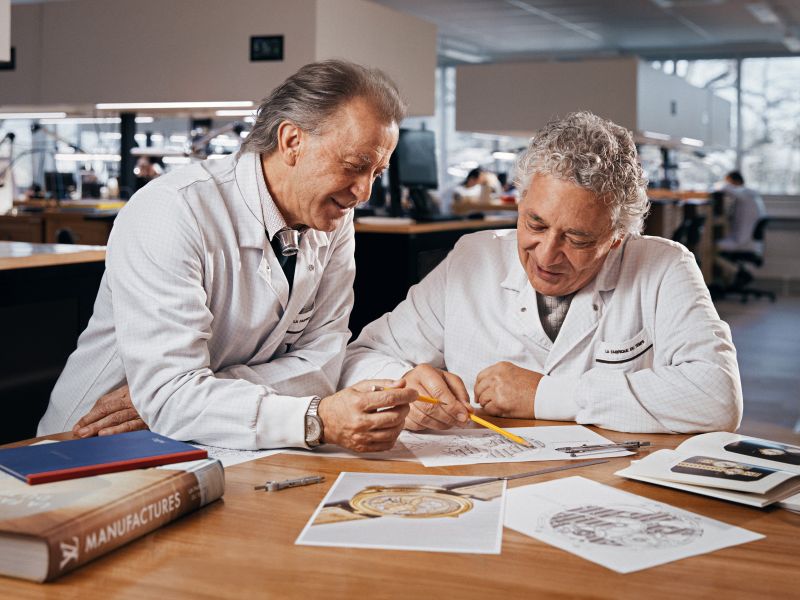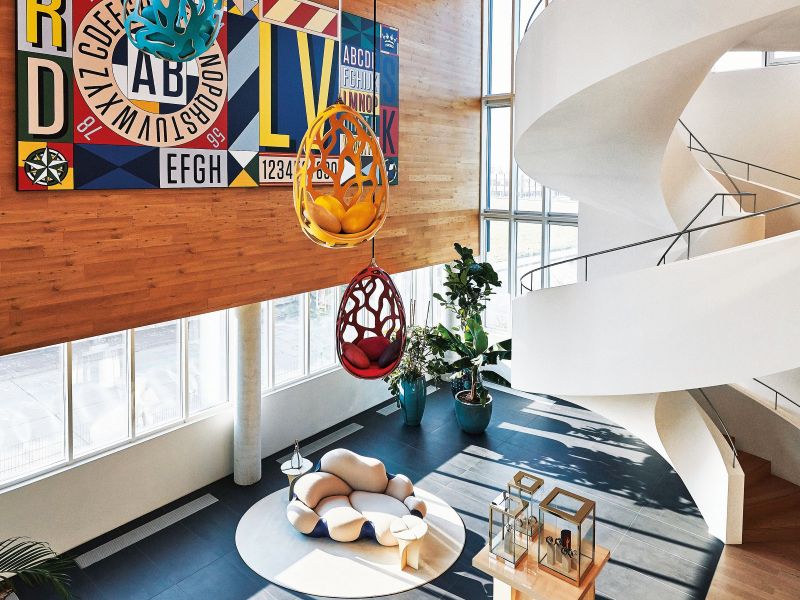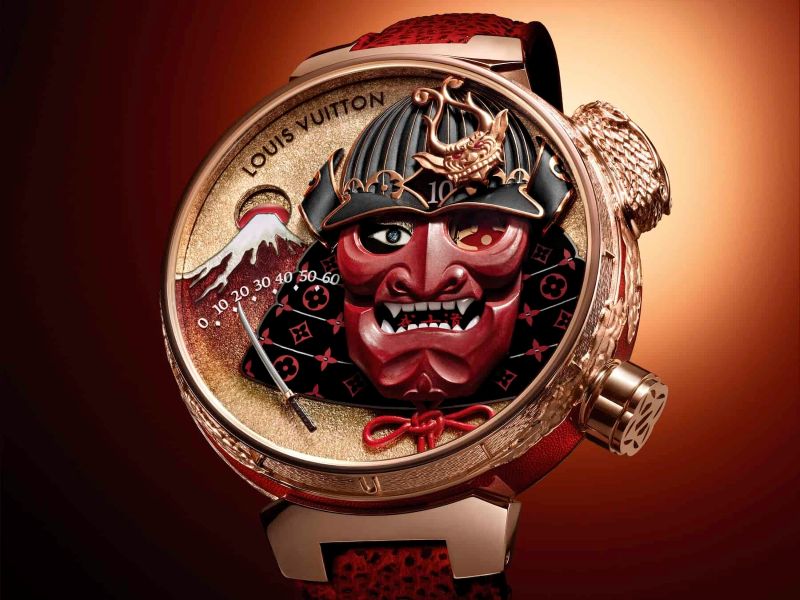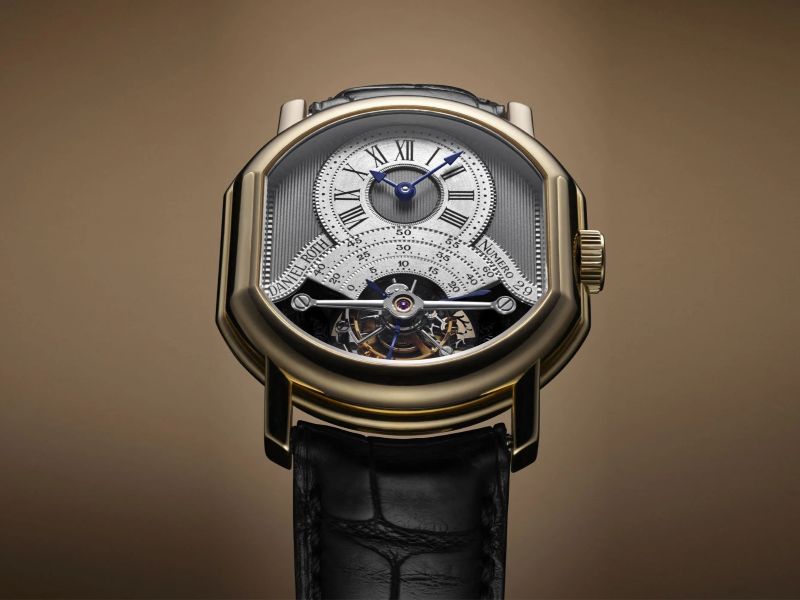
Co-founder of La Fabrique du Temps, Michel Navas (All photos: Louis Vuitton)
When Michel Navas welcomed 23-year-old Jean Arnault as director of marketing and development for Louis Vuitton’s watchmaking division in August 2021, the youngest scion of the LVMH dynasty — led by his father Bernard Arnault — was just three years older than the department he was tasked with shaping.
That warm flush of summer carried a quiet sense of hope. It heralded not only the first true season of breath and possibility after months of global pandemic standstill, but also the beginning of a pivotal chapter for the storied trunk purveyor, which had begun to etch its name into the horological canon after two decades in timekeeping.
“When you are 20, there are a lot of difficult decisions to make, whether to stay the course or rewrite the narrative,” Jean once analogised, likening the maison’s nascent venture to an excitable youth on the cusp of adulthood.
That was not Navas’ initial encounter with the spirited executive. In early 2020, after completing internships at McLaren Racing and Morgan Stanley, Jean visited the halls of La Fabrique du Temps (LFDT) — Louis Vuitton’s manufacture in Meyrin, a bucolic suburb outside Geneva — not with authority, but curiosity. Navas handed him a screw to clean and polish, only to be quickly admonished by a fellow staff member, who questioned whether assigning such a menial duty to a luxury empire protégé was going too far. Yet, armed with a fine abrasive and steady hand, clearly honed from a habit of taking apart and reassembling watch parts, Jean evinced the same unfettered enthusiasm that embodies Navas’ lifelong dedication: a reverence for the art of assembly.
It is impossible not to imagine the master watchmaker as a precocious child. In the past, children were allowed to pursue their inclinations only if they could be channelled into endeavours deemed orderly or purposeful. Drawn to barrels and balance wheels at the age of 10, however, the Spanish-born Navas was encouraged to tinker and troubleshoot, helping his watchmaker father and brother with repair work at home. The aria of ticking treasures, not cartoons on TV, filled the living room where others might have sought livelier entertainment.
Navas later received formal training at a now-defunct watchmaking school in the French city of Besançon, but the most valuable education came from toiling alongside master designers behind titans such as Audemars Piguet, Patek Philippe, Franck Muller and Gérald Genta. The latter was where Navas met his future business partner — and friend of nearly 40 years — Enrico Barbasini, with whom he founded LFDT in 2007. Their atelier would go on to serve a distinguished roster of clients, including Jacob & Co, Speake-Marin, Van Cleef & Arpels and Laurent Ferrier.
navas_and_enrico.jpg

Despite the mythology and romanticism surrounding the lone genius, this fortuitous duet between iconoclasts — the Paul Simon and Art Garfunkel or Daft Punk of the horological world — almost never came to be. Barbasini would have inherited the stage, much like his opera singer father, had the patriarch not crossed paths with a young vocalist during a tour in Zurich around the 1970s. The performer, it turned out, was a trained watchmaker who had braved the quartz crisis and made ends meet through singing. The study of cogs and calibres, it appeared, was a vocation worth embracing, the senior Barbasini mused.
The rapport and respect between Navas and Barbasini — “like an old couple who finish each other’s sentences”, quips current LFDT artistic director Matthieu Hegi — were not forged overnight. Prior to LFDT, the duo were given free rein at Franck Muller’s château, where they brought to life the famed Crazy Hours complication: a mechanical wonder born from Mr Muller’s frenetic imagination, allowing the hour hand to jump erratically between numerals while still keeping perfect time. Tensions arose, however, prompting them to exit the company and enlist Mathias Buttet, Muller’s then technical director, to set up BNB Concept (named after the trio’s combined initials). It was a one-stop shop for brands that did not have the capacity to produce complicated movements in-house.
Alas, this alliance, too, became entangled in lofty financial goals that clashed with the pair’s desire to “stay modest at all costs”. True growth arrived when Hamdi Chatti — then vice president of Louis Vuitton Jewellery & Watches who chalked up credentials at Piaget, Harry Winston and Montblanc — approached them with a game-changing proposal: Could they envision selling LFDT to the maison while preserving technical autonomy?
lfdt_interior_sf2022_812_02_rgb.jpg

Since debuting its showcase Tambour (French for “drum”) collection in 2002, Louis Vuitton has strived to solidify itself as a credible player in the cradle of Swiss watchmaking, all without shirking its fashion pedigree. Moreover, in 2009, it collaborated with LFDT to invent the patented and proprietary Spin Time movement, which translated jumping hours into rotating cubes. Navas and Barbasini eventually agreed, on the condition that they work towards attaining what the industry considers its highest distinction: the Poinçon de Genève, or Geneva Seal. Established in 1886, this prestigious hallmark is reserved for watches produced entirely within the canton, with all components finished by hand. (No spoiler: The Voyager Flying Tourbillon became Louis Vuitton’s first ticker to earn the certification in 2016.)
In July 2011, the maison acquired LFDT and, the following March, added dial-making workshop Léman Cadran to its fold to bolster supply chain integration. All that remained was bringing its watchmaking hub from La Chaux-de-Fonds that much closer to Geneva.
Drumming up change
When Louis Vuitton inaugurated its 4,000 sq m manufacture in October 2014, it did more than consolidate production and gather its artisans from La Chaux-de-Fonds under one roof. At the heart of the space stood a white spiralling staircase, its curves evoking the delicate coil of a watch spring. Though elegant in form, the structure posed considerable challenges during construction, finally emerging after several attempts as a sculptural statement of the house’s unbridled resilience. A test of skill, it also marked a symbolic shift: The maison would no longer be merely an établisseur, dependent on movements from ETA, Dubois-Dépraz, La Joux-Perret and Zenith. Instead, it would become a self-sustaining reservoir of innovation.
“Many were hesitant to join forces with Louis Vuitton because it was known primarily for its suitcases and fashion. But that’s exactly what made it exciting. Horology was a new territory, which gave us the freedom to execute our concepts and creativity. [Louis Vuitton’s] being young may seem like a handicap, but some prefer not to be bound by any legacy. I can develop things here that I couldn’t at Patek [Philippe],” says Navas, who was part of the team behind its iconic, porthole-inspired Nautilus — now among the most sought-after collector’s pieces from the 180-year-old pioneer.
Most watchmakers would be hard-pressed to name a creation that encapsulates their brand, but not Navas. “The Spin Time remains a proud achievement. Witnessing its multiple iterations over the years, such as the GMT, regatta countdown chronograph, colourful Escale and glow-in-the-dark Air Quantum … those were absolute fun.”
antipodefinal.jpg

Epiphany for the Spin Time struck Navas at the airport, where he was mesmerised by the rhythmic flip of departure boards, flapping panels that reveal destinations and times. The hypnotic kinetic display became the impetus for a complex jump hour that relies on 12 revolving cubes placed around the dial’s circumference to show the hour. Fittingly, the bulbous Tambour case provided the ideal architecture to house this voluminous yet intricate movement.
Often, the best ideas do not have to be grand. They could be tweaks, not blueprints. What began as fun hypotheses for the collection have since evolved into daring reinventions, with the Tambour Taiko Spin Time unfolding at LVMH Watch Week 2025. Clad in the Dolphin Grey colourway, six variants were introduced via a redesigned case named after the Japanese ceremonial taiko drum. A standout was the Air Antipode, a world time complication that tells the hour across 24 time zones simultaneously. Each cube stipulates two cities 12 hours apart, their faces colour-coded to specify AM or PM. Picture this: While you are waking up to the morning breeze in Los Angeles, a loved one may be lounging back with a sunset cocktail on the 122nd floor of the Burj Khalifa in Dubai.
Without fetishing the past, Louis Vuitton has the chance to reframe its horological future, in the same way its fashion disrupts the status quo and sparks viral indignation, all while feeding a hunger for what’s next. While one may assume breakthroughs occur in the maison’s sleek boardrooms, Navas discloses that many eureka moments actually transpire in informal settings such as the cafeteria, where artisans — including visiting guests like us — freely trade ideas over a casual cuppa.
“Do you know how many ‘stupid’ ideas we’ve had over the years?” Navas asks, half-expecting a serious reply. “Too many. But, sometimes, we try to execute those theories and they actually turn out pretty good. Everyone is honest with their opinions and speaks from the heart. Nothing is too ridiculous.”
Upending the expected can sometimes mean being a literal button-pusher. The jacquemart automaton Tambour Carpe Diem, which triggers a surrealist snake-and-skull tableau by pressing the pusher on right side of the case, won the Audacity Prize at the 2021 Grand Prix d’Horlogerie de Genève. Two years later, the Tambour Opera Automata led LFDT to China, spotlighting the art of Sichuan Opera’s “face changing”, bian lian. Unveiled just last month, the Tambour Bushido Automata, honouring the Japanese samurai code, exudes power and intimidation through a change of expression. The hours are inscribed on the helmet, and the minutes are indicated by a sleek katana sword gliding across a retrograde display.
Ever the trailblazer, Navas asserts, “How would you identify a good watch? If, 30 or 50 years from now, my peers were to take it apart, they’d still be impressed with the movement and the finishing of each component. That’s the definition of true craftsmanship. It needs to live on your wrist.”
bushdio_1.jpg

Clocked and loaded
It is easy to defer to age in a field where heritage often trumps novelty. But clarity can stem from those unburdened by history, to redraw the map without nostalgia clouding the view. Trust, after all, is invaluable: The pennies of faith you invest in your team today will be returned in dollars tomorrow.
On his second day as the newly promoted director of watches in 2022, Jean cleared out 80% of the existing portfolio to “start with a blank page”. Navas and Barbasini, wringing lessons from hard-earned wisdom, urged the new steward to “give up quartz” in favour of higher-end craftsmanship — a jarring move, given the movement’s significant contribution to the business. Elevating the maison’s upmarket ambitions called for nothing less than a deliberate reckoning, a shock to the system.
“Although we agreed on this direction together, Jean first asked us to trust him. He’s a young guy, a nice guy. But at that moment, he was our leader. And you need that belief [in the commander] to create the next Tambour or the icon for the next 20 years,” reiterates Navas.
“Our director shared this philosophy: In a two-car race, what matters isn’t just who finishes first or second — it’s the time gap between them. How many seconds faster is the leader? This isn’t just an inspiring metaphor; it’s the very same principle that has guided us since the inception of the Tambour Twin Chrono, a milestone in chronograph history.”
Teamwork, too, is about galvanising others towards a greater purpose. Jean kick-started the biennial Louis Vuitton Watch Prize for Independent Creatives to nurture emerging talent, offering a €150,000 grant, year-long mentorship with LFDT and strategic support across communication, copyright, marketing, industrial and financial developments — all to help bring a fledgling project into reality. Members of the jury include Rexhep Rexhepi, who seemed almost destined for the part, having worked at BNB before founding his own label, Akrivia, in 2012.
“Our first recipient was Raúl Pagès. Not many knew who he was until he won the prize, and now he’s being interviewed by The New York Times,” Navas says proudly of the laureate, best known for his Régulateur à Détente RP1, which showcases a rare pivoted detent escapement historically associated with marine chronometers. “Enrico and I don’t like to see our colleagues — or anyone, as a matter of fact — struggle. If we can, we will help.”
raul.jpg

Perhaps the most poignant expression of Louis Vuitton’s devotion to artistic independence lies in its revival of two dormant but seminal names: Daniel Roth, whom Jean describes as “a hero in the history of watchmaking and the first true independent”; and Gérald Genta, who, as a frustrated student of jewellery-making, famously flung his tools into the Rhône river before becoming a couturier of time. LVMH took over both brands in 2011 as part of its acquisition of Bvlgari, which had absorbed the ateliers a decade earlier.
“We felt it would be wrong to let Daniel Roth fade into obscurity. Bvlgari hadn’t done much with it,” says Navas.
Roth, now 79, was widely regarded as a key figure in lifting mechanical watchmaking from the doldrums of the quartz crisis. “Honouring the DNA of his foundational pieces is important to me, since Daniel and I are long-time friends. [Barbasini] and I visited him four times in the Vallée de Joux — well, he’s still alive, and we wanted his approval. He was very pleased when we showed him the Tourbillon Souscription, a faithful homage to the 1988 original. It was quite an emotional moment.”
As the prodigious Roth himself often proclaimed, la montre, objet d’art — the watch as a work of art. Few have lived that credo more fully. Long before his name graced dials, the virtuoso was captivated by Breguet’s influence, which he channelled with modern finesse into feats such as the tourbillon with an eight-day power reserve, the instantaneous perpetual calendar and the Westminster Grande Sonnerie with four cascading gongs. His signature double-ellipse case, and the C187 tourbillon within it, became emblems of unparalleled artistry.
Then, there was Genta, whom Navas worked with professionally for seven years.
“Genta was, as they say, a visionary. But, honestly, it was difficult to keep up with the demands. He was very exigent, and we had to assemble watches very quickly to satisfy clients. Despite having 120 people, the spirit of his company felt more like a start-up. The landscape of high watchmaking was entirely different in 1987 — can you imagine we used to make 70 minute repeaters in a year?”
daniel-roth.jpg

The pressure was immense, the pace relentless. Yet, even Navas admits it was within this very crucible that the master of chiming watches flourished. Among Genta’s many triumphs, beyond crafting one-offs for the King of Spain, Queen Mother of England and Sultan of Oman, was the Grand Sonnerie, which echoed the same chimes as Big Ben. His widow, Evelyne — now the Monégasque ambassador to the Court of St James’ — granted LFDT full access to his archives consisting of thousands of unrealised sketches. Previous to diplomacy, she was the sharp mind behind Genta’s business. The couple met at a dinner party in Monte Carlo in the early 1980s, a night she remembers vividly, not least because he spent it insisting that her watch was ugly.
“Genta was known for producing unique pieces mostly for close friends. But Mrs Genta wanted us to keep creating and move forward because she doesn’t want him to be forgotten. He never looked back because he was never interested in the past. ‘Please,’ she said as we hugged, ‘this is the best tribute you can pay to Mr Genta. You are in charge of reviving his legacy; so, don’t be stuck.’ It was comforting, knowing we had her blessing.”
LFDT honoured that by projecting his aspirations into the 21st century. Proof lies in the Gentissima Oursin Fire Opal, released this year. Adorned with 137 individually set fire opals encircling its yellow-gold case, it is an extension of the existing Oursin collection inspired by the simple sea urchin. Also commanding attention was Daniel Roth’s Extra Plat Souscription, an ultra-thin marvel sporting the emblematic double-ellipse case, with a clou de Paris guilloché patterned-dial and powered by the all-new DR002 calibre. For both brands, production will be limited to just a few hundred pieces per year, with some tourbillon exclusives capped at only 20.
In good hands
When the tools are set aside, Navas finds solace by retreating to the countryside. The campagne moves to its own rhythm — languid, unhurried — with the lake stretching into the distance and the misty Jura mountains rising like old companions. Along winding paths lined with trees and meadows, Navas, who enjoys cycling, finds a different kind of timekeeping — one without ticking hands, only the hush of the wind and cadence of turning pedals.
He no longer skis — a precaution or perhaps a reason to accompany his 27-year-old daughter, who broke her leg in an accident on the slopes. But even at rest, his thoughts seldom pause.
“At LFDT, we’re already thinking about 2027, even 2028. We’ve received thousands of calls from interested collectors for all three brands,” he says.
Precision matters in the cosmos of chrono but so does presence. How can watchmaking become more human?
“Our system isn’t overly academic,” reflects Navas. “But everyone works in harmony because our minds are aligned. We see ourselves as a laboratory of ideas, a think tank. And when we’re not working, we’re just like regular people — a family. That’s what allows us to operate on a human scale.”
A supporter of meaningful synergies, Navas is open to collaborations but, for now, he is content to leave the “who” in Jean’s hands. “As a watchmaker, I don’t want to push for this or that. Because Jean loves and appreciates watches, he will know best. I’m happy to stay behind the scenes and, if they need my expertise, I’m here,” he assures with a smile.
Where others default to the belief that there is safety in numbers and comfort in conformity, Louis Vuitton takes pride in resurrecting legacies and staying true to its artisanal roots. Long ago, Navas mentioned that collectors were attracted to the brand because it remained coveted on the wrists of the discerning — a reputation he was committed to upholding.
It seems he has kept his word.
This article first appeared on May 19, 2025 in The Edge Malaysia.


